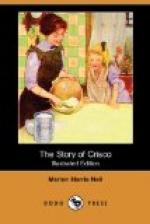Eggs
A mode of ascertaining the freshness of eggs is to hold them before a lighted candle or to the light, and if the egg looks clear, it will be tolerably good; if thick, it is stale; and if there is a black spot attached to the shell, it is worthless. No egg should be used for culinary purposes with the slightest taint in it, as it will render perfectly useless those with which it has been mixed. Eggs may be preserved, however, for a considerable time without any further special precaution than that of keeping them in a cool place. A very effective method of preserving eggs for winter use is to rub a little melted Crisco over each to close the pores, and then to pack the eggs in bran, salt or sawdust, not allowing them to touch each other.
[Illustration]
Methods of Cooking
There are seven chief methods of cooking meat—roasting, boiling, baking, stewing, frying, broiling and poaching.
The first three are most suitable for joints weighing four pounds or more, but not satisfactory for smaller pieces which are liable to become hard and flavorless by the drying up or loss of their juices.
Of the other three methods, stewing may be applied to fairly large and solid pieces, but it is better for smaller thin ones, while frying and broiling can be used only for steaks, chops, and similar cuts.
Braising and steaming are combinations and modifications of these methods.
Roasting
Roasting is one of the oldest methods of cooking on record, and still remains the favorite form of cooking joints of meat or birds. The success of every method of cooking depends largely upon the correct management of the fire. In roasting, this is particularly the case, as a clear, brisk and yet steady fire is needed. To roast a joint it should be placed before great heat for the first ten minutes and then allowed to cook more slowly. The great heat hardens the outside of the meat and keeps in the juices. If allowed to cook quickly all the time the meat is likely to be tough. The fire should be bright and clear. The joint should be basted about every ten minutes, as this helps to cook it, keeps it juicy and improves the flavor. The time allowed is fifteen minutes for every pound, twenty minutes over for beef and mutton; for veal and pork twenty minutes for every pound and thirty minutes over.
Oven Roasting
Roasting in the oven of ordinary coal stoves or ranges is not considered so good as roasting before an open fire; nevertheless it may be said safely that the greatest part of meat roasting is done in close ovens. It appears, from various experiments that meat roasted or baked in a close oven loses rather less of its weight than if roasted by an open fire.
The excellence of a roast depends to a great extent upon the amount of basting it receives.




